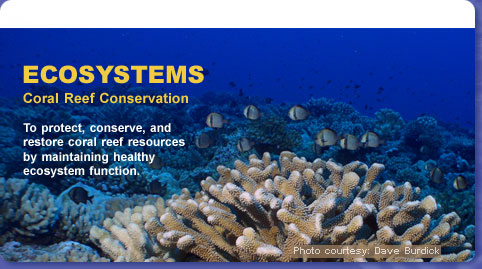









NOAA - Ecosystem Goal Team - To protect, restore and manage the use of coastal and ocean resources through an ecosystem approach to management
Protected Species
Program Mission
The Protected Species Program (PSP) is responsible for the conservation of marine mammals and other endangered species listed under the Endangered Species Act (ESA), Marine Mammal Protection Act (MMPA), and other statutes and international treaties and conventions. The PSP vision is that marine animals and endangered marine life are protected, and its mission is to provide oversight and guidance on the conservation of marine mammals, endangered species, and their habitats.
PSP achieves its mission through five main Capabilities: proactive conservation efforts, listing of species in need of protection, recovery and conservation of protected species, outreach and education, and international activities. Proactive conservation efforts help species that are approaching the need for listing. Once a species becomes threatened or endangered, the PSP is responsible for the formal listing process of the species and designation of critical habitat. The majority of the PSPs work is on recovery and conservation of these species. This involves managing and planning to remove or minimize human impacts, and stabilizing populations to make them functional members of their ecosystem. The Outreach and Education capability informs the public about NOAA's activities related to protected resources and issues, and the International capability provides leadership, educations, training, enforcement, and outreach support to other countries so that they can help in the recovery and conservation of protected species. Finally, the PSP works closely with the Ecosystem Observations (EOP) and Ecosystem Research (ERP) Programs which provide the monitoring, assessment, and management-directed research needed for conservation decision making.
Ecosystem Approaches to Management
As the program has evolved, the PSP has moved from single species management to Ecosystem Approaches to Management (EAM). This holistic approach enables the program to be more adaptive, taking into account various ecosystem processes and functions, and considering multiple external influences. For example, the PSP incorporates EAM into its Sea Turtle program and Puget Sound salmon recovery efforts. The major threats to sea turtles in the U.S. are destruction of nesting and foraging habitat; incidental capture in fisheries; entanglement in marine debris; and vessel strikes. PSP mitigates these threats by developing, testing, and implementing bycatch reduction solutions; collecting information on fisheries bycatch of sea turtles; reducing the effects of dredging, marine habitat alterations, vessel strikes and other human threats; monitoring populations at feeding areas and key nesting beaches; researching sea turtle biology and ecology; preserving key nesting sites; and implementing multi-lateral treaties and agreements for sea turtle conservation and recovery.
Similarly, the Puget Sound salmon recovery efforts aim to recover self-sustaining, harvestable salmon runs that contribute to the overall health of the Sound and the region's economic vitality and prosperity. The PSP approaches recovery by limiting salmon threats by protecting estuaries and nearshore areas; restoring flood plains and riparian areas; improving water quantity and quality; increasing fish access; and managing/integrating harvest, hatcheries and habitat. This approach has proven to be adaptive, collaborative, considering multiple external factors, and striving to balance diverse societal objectives.
Ecosystem Programs |
||
 |
 |
 |
 |
 |
 |
 |
 |
 |
Program Manager:
Phil Williams
Phil.Williams@noaa.gov
Program Coordinator:
Philip Hoffman
Philip.Hoffman@noaa.gov
Website:
Protected Species Program

